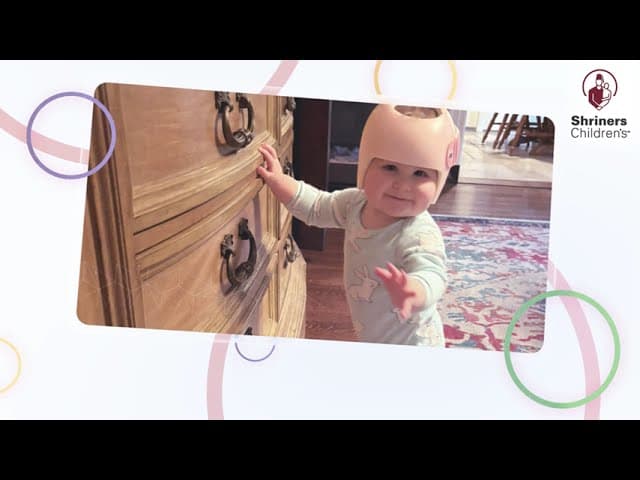Serafina's Experience with Cranial Remolding

Serafina's Experience with Cranial Remolding
[title card: Serafina's Story]
[Shriners Children's logo]
Speaker:
I was at a regular, well baby checkup and the pediatrician noticed that my daughter was not turning her head properly to one side. The other side was fine and it was suspected at birth because she was frank breach in utero. And so her head was stepped one side. At seven months, they realized that her head really was not turning well the one way. So we got referred to Shriners and got right in for an appointment during which everything was able to happen at one time. So we saw the nurse practitioner, she did measurements, she evaluated, then we immediately got to see the physical therapist and she recommended that we go to POPS to get a um, more thorough evaluation of the shape of the head. The nurse practitioners diagnosed her with both plagiocephaly, the flat head caused by the torticollis, the inability to shift her neck in both directions.
And I had never heard either of those terms for my own children or in general. And I was intimidated by them. And I felt terrible that my child was going through something that we didn't realize, you know, was a diagnosis, let alone one that she had. So I had a lot of questions that they answered so thoroughly and so kindly, and I was so glad that the moment that we heard those diagnoses, there was also a plan set in place the same day. So it wasn't diagnosis, panic, panic, and then wait to get in to see someone to have a plan of action. Everything was able to happen in the one appointment since there, or all the practitioners under one roof.
When the POPS team did the 3D model of my daughter's head, I was shocked 'cause it looks different in person. You know, you're looking at the head that you see every single day, but whenever they show the deficit or the flat spot, it's really shocking. And I was so grateful 'cause they gave a really accurate measurement. When I saw it on the screen. I knew immediately that I would go through with whatever intervention POPS recommended. Um, whereas before I was sort of on the fence if she would need the helmet or not.
My initial reaction, I thought that it would be painful for her and also complicated for us as parents to, um, navigate. But I did not yet understand how it worked. And Hannah, in the pops department explained how it works, how it's not painful for the baby and it allows the baby's head to grow properly rather than molding it like clay. Like it doesn't actually hurt them at all. And then once it was on Seraphina, it was, she had no idea, she didn't even care. They're so young and they're the age where they're just starting to explore their environment. They don't have any clue that there's something very lightweight and very easy to put on on their head. And the care of it was very simple. You just take it off whenever they're about to go into the bath, clean it with rubbing alcohol and let it air dry.
I would tell a parent who's facing a similar situation with their child to ask all the questions to trust Shriners because every question I had, if it did not belong to the department I was asking it of, they would forward that question on to someone else and give it right back to me. So no one ever said, I don't know. No one ever said, that's not my department. They would find the answer for me, give it back, um, or match me with a practitioner that would be able to answer the question.
Oh my goodness. When she graduated from the helmet, I cried. I was so excited. They gave her a certificate with her name and the date of her graduation and everybody was congratulatory. She did so well with the helmet and I'm just so grateful to the professionals that worked with us. But they got us in and out in four months.
[Shriners Children's logo]